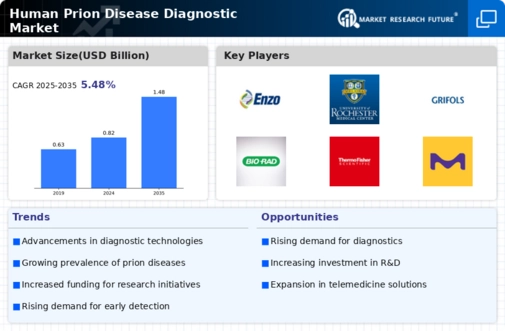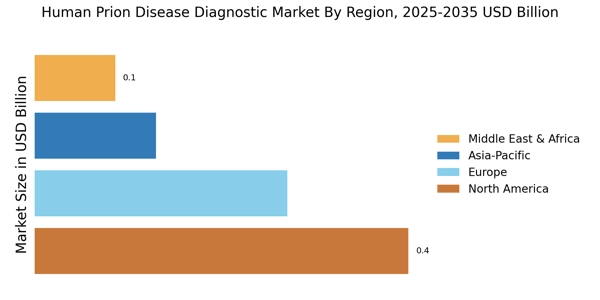Rising Incidence of Prion Diseases
The increasing incidence of prion diseases, such as Creutzfeldt-Jakob disease, is a notable driver for the Human Prion Disease Diagnostic Market. As awareness of these rare but fatal conditions grows, healthcare providers are more vigilant in diagnosing potential cases. Reports indicate that the prevalence of prion diseases has been on the rise, leading to heightened demand for effective diagnostic tools. This trend is likely to stimulate investment in research and development, as well as the introduction of innovative diagnostic technologies. Consequently, the market is expected to expand as healthcare systems seek to improve their diagnostic capabilities and ensure timely intervention for affected patients.
Advancements in Diagnostic Technologies
Technological advancements in diagnostic methodologies are significantly influencing the Human Prion Disease Diagnostic Market. Innovations such as real-time quaking-induced conversion (RT-QuIC) and other sensitive assays have emerged, enhancing the accuracy and speed of prion disease detection. These advancements not only improve patient outcomes but also facilitate earlier diagnosis, which is crucial for effective management. The market is projected to grow as these technologies become more widely adopted in clinical settings. Furthermore, the integration of artificial intelligence and machine learning in diagnostic processes may further revolutionize the industry, leading to more precise and efficient diagnostic solutions.
Increased Funding for Prion Disease Research
The Human Prion Disease Diagnostic Market is experiencing growth due to increased funding for research initiatives focused on prion diseases. Governments and private organizations are recognizing the need for enhanced understanding and treatment of these conditions, leading to substantial financial support for research projects. This influx of funding is likely to accelerate the development of novel diagnostic tools and therapies, thereby expanding the market. As researchers explore the underlying mechanisms of prion diseases, the insights gained may lead to breakthroughs in diagnostics, ultimately benefiting patients and healthcare providers alike.
Regulatory Support for Diagnostic Innovations
Regulatory support for innovative diagnostic solutions is playing a pivotal role in shaping the Human Prion Disease Diagnostic Market. Regulatory agencies are increasingly recognizing the importance of rapid and accurate diagnostics for prion diseases, leading to streamlined approval processes for new technologies. This supportive environment encourages companies to invest in the development of cutting-edge diagnostic tools, which can lead to improved patient outcomes. As regulatory frameworks evolve to accommodate advancements in technology, the market is expected to benefit from a surge in innovative products that enhance diagnostic capabilities and address the challenges associated with prion disease detection.
Growing Awareness Among Healthcare Professionals
The growing awareness of prion diseases among healthcare professionals is a critical driver for the Human Prion Disease Diagnostic Market. As medical education increasingly incorporates information about these rare diseases, clinicians are better equipped to recognize symptoms and pursue appropriate diagnostic tests. This heightened awareness is likely to result in more frequent testing and earlier diagnosis, which can significantly impact patient management. Additionally, continued professional development and training programs focused on prion diseases may further enhance diagnostic practices, contributing to market growth as healthcare systems adapt to evolving knowledge in this area.


















Leave a Comment